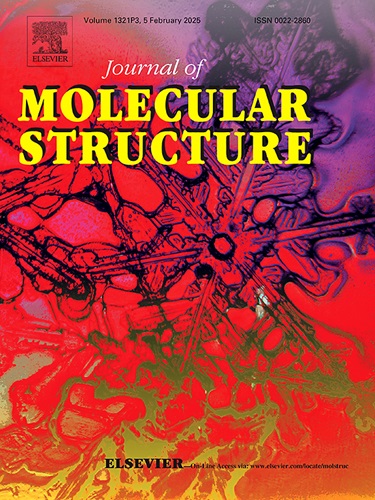A novel bio-nanocatalyst Ni-CS NPs/MWCNT@AlFe2O4 for the click synthesis of 5-phenyl-1H-tetrazole
IF 4
2区 化学
Q2 CHEMISTRY, PHYSICAL
引用次数: 0
Abstract
This study introduces a novel bio-nanocatalyst, Ni-CS NPs/MWCNT@AlFe2O4, which consists of nickel-chitosan nanoparticles (Ni-CS NPs) anchored on magnetic multi-walled carbon nanotubes (MWCNTs) supported by an aluminum ferrite (AlFe2O4) matrix. This innovative catalyst is specifically engineered for the efficient click synthesis of 5-phenyl-1H-tetrazole through the reaction of benzonitrile with sodium azide. Leveraging the unique properties of its composite components, the Ni-CS NPs/MWCNT@AlFe2O4 catalyst facilitates rapid and selective synthesis under benign reaction conditions, enhancing both yield and reaction speed relative to conventional methods. Furthermore, the magnetic nature of the AlFe2O4 support allows for easy recovery and reuse of the catalyst, embodying principles of green chemistry by reducing waste and avoiding hazardous solvents. The catalyst was synthesized and characterized using various techniques, including (SEM), (TEM), and (XRD), confirming its structural integrity and magnetic properties. Notably, the bio-nanocatalyst exhibited excellent reusability, maintaining its activity over multiple reaction cycles without significant performance loss. This work highlights the potential of Ni-CS NPs/MWCNT@AlFe2O4 as an effective and sustainable catalyst for click chemistry, paving the way for further advancements in synthesizing nitrogen-rich heterocycles.

一种新型生物纳米催化剂Ni-CS NPs/MWCNT@AlFe2O4用于5-苯基- 1h -四唑的点击合成
本研究介绍了一种新型生物纳米催化剂Ni-CS NPs/MWCNT@AlFe2O4,它由镍壳聚糖纳米颗粒(Ni-CS NPs)锚定在由铝铁氧体(AlFe2O4)基质支撑的磁性多壁碳纳米管(MWCNTs)上组成。这种创新的催化剂是专门为通过苯腈与叠氮化钠的反应高效合成5-苯基- 1h -四氮唑而设计的。利用其复合组分的独特性质,Ni-CS NPs/MWCNT@AlFe2O4催化剂有助于在良性反应条件下快速和选择性地合成,相对于传统方法提高了收率和反应速度。此外,AlFe2O4载体的磁性使催化剂易于回收和再利用,通过减少浪费和避免有害溶剂,体现了绿色化学的原则。采用SEM、TEM、XRD等技术对催化剂进行了合成和表征,证实了催化剂的结构完整性和磁性能。值得注意的是,该生物纳米催化剂表现出优异的可重复使用性,在多个反应周期中保持其活性而没有明显的性能损失。这项工作强调了Ni-CS NPs/MWCNT@AlFe2O4作为一种有效和可持续的点击化学催化剂的潜力,为进一步合成富氮杂环铺平了道路。
本文章由计算机程序翻译,如有差异,请以英文原文为准。
求助全文
约1分钟内获得全文
求助全文
来源期刊

Journal of Molecular Structure
化学-物理化学
CiteScore
7.10
自引率
15.80%
发文量
2384
审稿时长
45 days
期刊介绍:
The Journal of Molecular Structure is dedicated to the publication of full-length articles and review papers, providing important new structural information on all types of chemical species including:
• Stable and unstable molecules in all types of environments (vapour, molecular beam, liquid, solution, liquid crystal, solid state, matrix-isolated, surface-absorbed etc.)
• Chemical intermediates
• Molecules in excited states
• Biological molecules
• Polymers.
The methods used may include any combination of spectroscopic and non-spectroscopic techniques, for example:
• Infrared spectroscopy (mid, far, near)
• Raman spectroscopy and non-linear Raman methods (CARS, etc.)
• Electronic absorption spectroscopy
• Optical rotatory dispersion and circular dichroism
• Fluorescence and phosphorescence techniques
• Electron spectroscopies (PES, XPS), EXAFS, etc.
• Microwave spectroscopy
• Electron diffraction
• NMR and ESR spectroscopies
• Mössbauer spectroscopy
• X-ray crystallography
• Charge Density Analyses
• Computational Studies (supplementing experimental methods)
We encourage publications combining theoretical and experimental approaches. The structural insights gained by the studies should be correlated with the properties, activity and/ or reactivity of the molecule under investigation and the relevance of this molecule and its implications should be discussed.
 求助内容:
求助内容: 应助结果提醒方式:
应助结果提醒方式:


